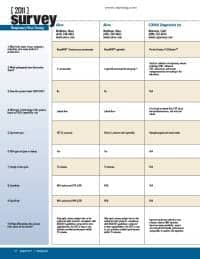Luminex Corp, Austin, Tex, has received FDA clearance for a new version of xTAG CYP2D6 Kit.
“Pharmacogenetics is a fast-growing field and our flexible technology provides laboratories unique options to address their needs,” says Patrick J. Balthrop, president and CEO, Luminex. “Attaining FDA and CE clearance for xTAG CYP2D6 Kit demonstrates Luminex’s commitment to offering diagnostics that optimize patient outcomes and lower overall health care costs.”
Cytochrome P450 2D6 (CYP2D6) is a clinically important gene that encodes a phase one drug metabolizing enzyme. CYP2D6 metabolizes greater than 25% of the drugs in use today including cardiovascular drugs, antipsychotics, antidepressants, pain medications, ?-blockers, antiemetics, antiarrhythmics, and anticancer drugs. Variations in the CYP2D6 gene can result in distinct drug metabolizing phenotypes leading to suboptimal drug responses, such as drug toxicity, adverse drug reactions (ADRs), or inadequate therapeutic effect. An estimated 2.2 million serious ADRs occur yearly resulting in 100,000 deaths at a cost of $136 billion in the United States alone.1,2
xTAG CYP2D6 Kit is an IVD assay that analyzes a patient’s CYP2D6 genotype from DNA extracted from a blood sample to aid physicians in determining therapeutic strategy for drugs metabolized by the cytochrome P450 2D6 gene product. The assay is run on the Luminex® 100/200™ instrument. This new version of the kit optimizes performance on the *17 allele and features an updated software algorithm that detects all 17 genotypes that the assay is cleared for, including deletion and duplication genotypes.
Luminex has also submitted xTAG CYP2C19 Kit for FDA clearance. The CYP2C19 enzyme is responsible for metabolizing a variety of prodrugs and drugs used to treat ulcers, seizures, malaria, and anxiety. It is also partially responsible for metabolizing drugs such as beta-blockers and some antidepressants.
[Source: Luminex Corp]
Sources:
1. Lazarou J, Pomeranz B, Corey PN. Incidence of adverse drug reactions in hospitalized patients: A meta-analysis of prospective studies. JAMA 1998;279:1200–1205
2. Johnson JA, Bootman JL. Drug-related morbidity and mortality. A cost-of-illness model. Arch Intern Med 1995;155(18):1949–1956


